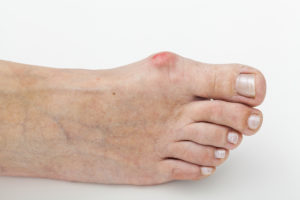There are many complicated musculoskeletal assessments you can perform to evaluate flat feet (i.e., overpronation). However, there are also many easy to interpret visual clues (if you know what to for) you can use an overpronation assessment to tell you if you overpronate and whether this problem might be the cause of your foot and/or ankle pain.
Overpronation Assessment
Take a look at your feet. The appearance of bunions, calluses, toes that are “scrunched” together, swelling and inflammation of the feet/ankles and feet that are turned out like a duck (i.e., abducted) all suggest that you overpronate.
 So how do we know that these visual clues point to overpronation? Overpronation is characterized by a collapsing inwards of the foot and ankle toward the midline of the body. This means that weight is transferred across the inside of the foot and ankle, rather than being transferred forward over the end of the toes. This excessive pressure over the inside of the foot causes inflammation to the first joint of the big toe (i.e. bunions), calluses and the toes to “scrunch” together (image right). Furthermore, as the foot and ankle collapse inward with overpronation the knee follows. This excessive movement of the knee toward the midline pulls the shin bones out of alignment.
So how do we know that these visual clues point to overpronation? Overpronation is characterized by a collapsing inwards of the foot and ankle toward the midline of the body. This means that weight is transferred across the inside of the foot and ankle, rather than being transferred forward over the end of the toes. This excessive pressure over the inside of the foot causes inflammation to the first joint of the big toe (i.e. bunions), calluses and the toes to “scrunch” together (image right). Furthermore, as the foot and ankle collapse inward with overpronation the knee follows. This excessive movement of the knee toward the midline pulls the shin bones out of alignment.
 In compensation for this position of the knee the foot usually turns outward to help rotate the shin bones outwards also. This is seen in an unusual position of the feet (i.e., turned out) (image left).
In compensation for this position of the knee the foot usually turns outward to help rotate the shin bones outwards also. This is seen in an unusual position of the feet (i.e., turned out) (image left).
Knowing what to look for in the feet (and what these clues mean) can help you understand your underlying musculoskeletal and movement balances and make a self-assessment as to whether overpronation may be causing your foot and ankle problems.
To learn how to assess each part of the body from head to toe and discover the underlying causes of aches and pains check out Module 1 (i.e., The Fundamentals of Structural Assessment) of The BioMechanics Method Corrective Exercise Specialist program or click on the image below.
